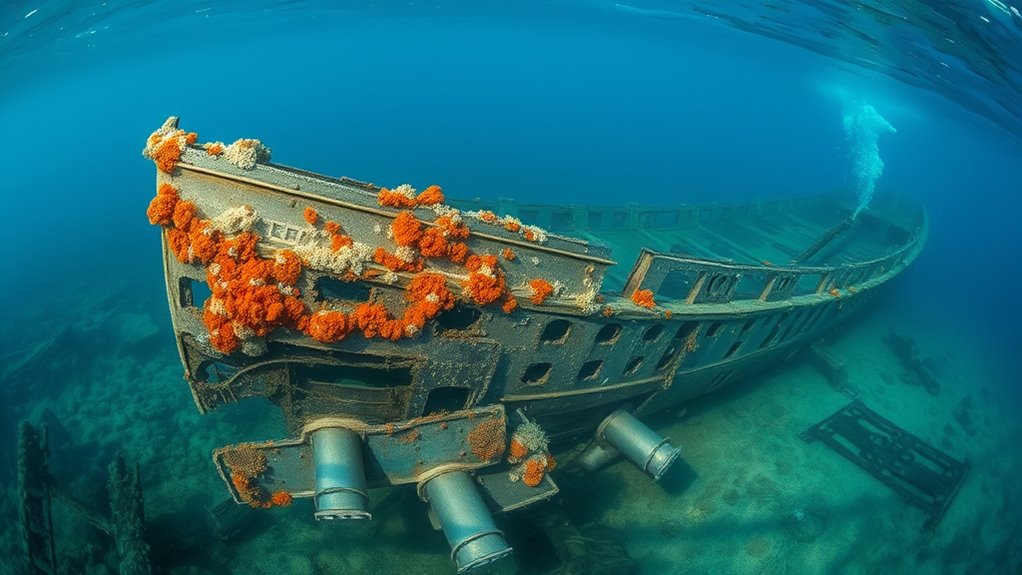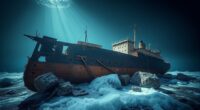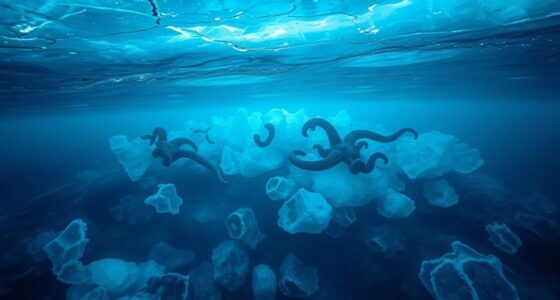The wreck of Shackleton’s Endurance was finally found using advanced underwater drones and sonar mapping in the harsh, icy waters of the Weddell Sea. Charting treacherous ice packs and shifting ice layers took careful planning and technology. The environment’s extreme cold helped preserve the ship and its artifacts, making this discovery a major breakthrough in maritime archaeology. If you want to learn more about how these innovations made the find possible, keep exploring these incredible details.
Key Takeaways
- Advanced sonar mapping and underwater drones were crucial in locating the wreck beneath thick sea ice.
- Remotely operated vehicles (ROVs) carefully explored the icy seabed without disturbing the environment.
- The harsh, shifting ice conditions required meticulous planning and navigation to access the wreck site.
- The cold, icy environment preserved the Endurance in remarkably good condition, aiding its discovery.
- Technology and environmental understanding combined to finally reveal the well-preserved wreck after over a century.

After decades of mystery, the wreck of the Endurance has finally been discovered beneath the icy waters of the Weddell Sea. This remarkable find marks a pivotal moment in maritime archaeology, offering a rare glimpse into the past and the enduring legacy of Ernest Shackleton’s legendary expedition. The cold, icy environment played a crucial role in preserving the ship, keeping it remarkably intact despite the relentless passage of time. Unlike many sunken vessels, the Endurance’s excellent ice preservation means you’re likely to find well-preserved wood, metal, and artifacts that tell stories from over a century ago. This high level of preservation allows researchers to study the wreck in extraordinary detail, providing insights into early 20th-century shipbuilding techniques and the harsh conditions explorers faced.
The discovery was no small feat; it required advanced technology, patience, and meticulous planning. You can imagine the challenges faced in steering the treacherous, ice-choked waters of the Weddell Sea, where thick ice packs continually shift and reshape the landscape. Using state-of-the-art underwater drones and sonar mapping, explorers gradually narrowed down the location. Once they pinpointed the site, they carefully deployed remotely operated vehicles (ROVs) to investigate the seabed. The precision of these tools is essential in maritime archaeology, especially in such a forbidding environment, as they allow you to explore without disturbing the fragile ice and sediment layers that have enveloped the wreck for over a hundred years.
The icy conditions have not only preserved the wreck but also created a unique environment that reduces biological activity, which might otherwise accelerate deterioration. This natural preservation provides a rare opportunity for scientists and historians to examine the vessel in its near-original state. As you consider this discovery, it becomes clear how essential ice preservation is in maritime archaeology; it turns what could have been a decayed relic into a time capsule, opening a window into the past. The discovery of the Endurance isn’t just about a sunken ship; it’s about unlocking a chapter of human endurance, exploration, and adventure. This find will undoubtedly deepen our understanding of early polar expeditions and highlight the importance of preserving our maritime history in icy environments.
Furthermore, the frozen environment’s preservation effect has parallels with ice preservation, which is crucial in maintaining the integrity of underwater archaeological sites in polar regions.
Frequently Asked Questions
What Technology Was Used to Locate the Wreck?
You might wonder what technology helped locate the wreck. Underwater sonar played a key role, emitting sound waves to map the ocean floor and detect objects like the wreck. Remote sensing techniques, including satellite imagery and aerial surveys, complemented sonar data, providing broader context. Together, these tools allowed explorers to pinpoint the wreck’s location accurately, making the discovery possible and revealing the ship’s resting place beneath the icy waters.
How Deep Is the Endurance Wreck Beneath the Ice?
You might wonder how deep the Endurance wreck lies beneath the ice. It rests at an ice depth of approximately 300 meters, where ocean pressure is intense. This depth makes locating and exploring the wreck challenging because the thick ice and high pressure demand specialized equipment. Despite these obstacles, advanced sonar and remotely operated vehicles helped uncover its precise location, revealing the ship’s resting place beneath the icy Antarctic waters.
Who Led the Expedition to Find the Wreck?
Like a detective solving a cold case, you’d find that the expedition to locate the wreck was led by maritime archaeology expert Dr. Jennifer Landsberg. Her team combined cutting-edge technology with polar exploration skills, steering icy waters to uncover the long-lost Endurance. This remarkable journey showcased the dedication of explorers and scientists working together, pushing the boundaries of what’s possible in polar exploration and maritime archaeology.
Are There Any Artifacts Still Intact Inside the Wreck?
You might wonder if artifacts inside the wreck are still intact. Due to incredible ice preservation, many items remain remarkably well-preserved, despite decades underwater. The cold environment slows decay, helping maintain artifact condition. You can see tools, personal belongings, and even parts of the ship that tell the story of the expedition. This preservation gives you a rare glimpse into the past, allowing you to connect with Shackleton’s brave journey firsthand.
What Challenges Did Explorers Face During the Search?
Imagine steering icy waters like a captain steering through a storm—explorers faced similar struggles. You encounter leadership challenges as team members grow weary and uncertain, while environmental obstacles like treacherous ice, unpredictable weather, and deep ocean currents threaten your mission. These harsh conditions test your resolve, requiring resilience, strategic planning, and teamwork to overcome. Such challenges made the search for Shackleton’s wreck an arduous yet inspiring quest.
Conclusion
You’ve just uncovered the incredible story of Shackleton’s Endurance wreck, finally found after over a century. Did you know that the ship rests about 10,000 feet beneath the Antarctic ice? That’s nearly twice the height of Mount Everest! This discovery not only honors Shackleton’s legendary leadership but also shows how perseverance can uncover history’s hidden treasures. Now, you’ve seen how determination and technology can bring the past back to life in astonishing ways.









